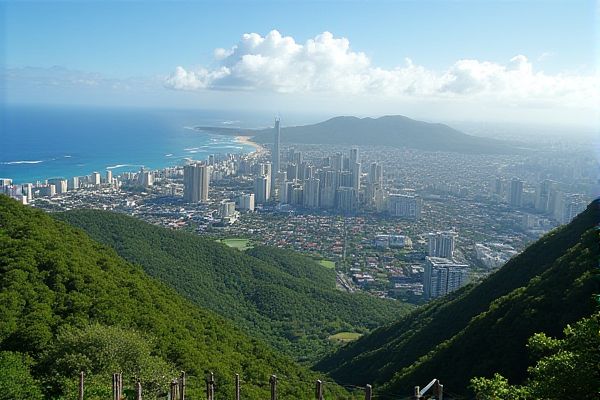
Dining and food culture in Hawaii: Emphasis on fresh, local ingredients. Popularity of poke bowls. Plate lunch tradition. Influence of Asian cuisines. Importance of taro and poi. Spam musubi as a snack staple. Unique tropical fruits available. Luaus with traditional Hawaiian dishes. Malasadas as popular sweets. Coffee culture, especially Kona coffee.
Emphasis on fresh, local ingredients.
Hawaiian cuisine places a strong emphasis on fresh, local ingredients, such as kalo (taro plant) and seafood from the surrounding waters, highlighting traditional dishes like poi, kalua pig, and poke, which maximize the use of local resources and minimize waste, reflecting a deep respect for the land and its bounty. For those interested in exploring these flavors firsthand, A Taste of Aloha: Exploring Hawaiian Cuisine offers a unique culinary journey through the islands. By embracing delicacies that are deeply ingrained in Hawaiian culture, visitors can truly appreciate the harmonious relationship between the people and their environment.
Popularity of poke bowls.
Poke bowls, a traditional Hawaiian dish of cubed raw fish seasoned and often served over sushi rice, have gained immense popularity both in Hawaii and on the U.S. mainland due to their health benefits, customization options, and convenience. The dish, rooted in Hawaiian culture with influences from Japanese and other immigrant cuisines, has evolved to include various ingredients and preparations while maintaining its core traditional elements. For more insights into the cultural significance and diverse variations of this dish, you can explore more details at Tiki Thai Maui. These bowls continue to captivate food enthusiasts around the world with their vibrant flavors and nutritious profiles.
Plate lunch tradition.
A Hawaiian Plate Lunch is a traditional meal consisting of two scoops of rice, one scoop of macaroni salad, and a choice of protein such as teriyaki beef, chicken katsu, or kalua pork. This delicious combination originated from the multicultural culinary exchanges among plantation workers in the 1880s and has become a staple of [Hawaiian food culture](https://hawaiisbesttravel.com/hawaiian-plate-lunch/). The unique blend of flavors and influences showcases the harmonious fusion found in Hawaii's diverse community, making it a beloved dish both for locals and visitors alike.
Influence of Asian cuisines.
The influence of Asian cuisines, particularly Japanese, is profound in Hawaiian food culture, evident in dishes like the Hawaiian Plate Lunch, musubi (a fusion of Spam and Japanese rice balls), and kakigori (shave ice), which reflect the blending of Japanese culinary traditions with local Hawaiian ingredients. Other Asian influences, such as Chinese, Korean, and Filipino cuisines, have also shaped Hawaiian cuisine through the introduction of dishes like stir-fries, kimchi, and barbecue styles, contributing to the unique fusion known as "local food".
Importance of taro and poi.
Taro and poi are cornerstone elements in Hawaiian cuisine and culture, with taro being a nutrient-rich, sacred crop that is transformed into poi, a staple food made by mashing cooked taro into a paste that can range from viscous to liquid consistency. This dish is deeply embedded in Hawaiian tradition, spirituality, and daily life, and you can learn more about its significance and preparation by visiting the comprehensive resource on Wikipedia.
Spam musubi as a snack staple.
Spam Musubi, a snack featuring grilled Spam atop a block of rice wrapped in nori, is a beloved staple in Hawaiian cuisine, originating from the mid-20th century when Spam became popular during World War II. It has since evolved into a cultural icon and versatile snack reflecting Hawaiian heritage and innovation. To delve deeper into its fascinating background, explore the rich history of Spam Musubi, which highlights its significance and transformation within the islands. This delightful snack continues to captivate both locals and visitors, showcasing the unique fusion of flavors and cultural influences that make Hawaiian cuisine truly special.
Unique tropical fruits available.
Hawaii offers a diverse array of unique tropical fruits, including Pineapple, Mango, Papaya, Guava, Lilikoi (Passion Fruit), Starfruit, Rambutan, Breadfruit, and Dragon Fruit, each with distinct flavors and uses in local cuisine. For more information on these exotic fruits and their vibrant presence in Hawaiian culinary traditions, visit this Exploration of Hawaiian Fruits that highlights their importance and versatility in local dishes.
Luaus with traditional Hawaiian dishes.
A traditional Hawaiian luau features a variety of dishes, including Kalua pig cooked in an underground oven (imu), lau lau (meat wrapped in taro leaves and steamed), poi (pounded taro root), and poke (raw fish marinated in soy sauce and other seasonings). These dishes are often served alongside other local favorites like haupia (coconut pudding) and macaroni salad, reflecting Hawaii's diverse and rich culinary culture. For more on this fascinating aspect of Hawaiian culture, you can visit the Hawaiian Culture Luau website.
Malasadas as popular sweets.
Malasadas, brought to Hawaii by Portuguese immigrants in the late 19th century, are deep-fried doughnuts without holes, made with a rich yeast dough incorporating many eggs, resulting in a light and fluffy texture. They are often coated with sugar and come in a variety of fillings such as passionfruit, custard, chocolate, and more, making them a staple in Hawaiian pastry shops and cultural gatherings. For more on these delectable treats, visit the Food Republic website to dive deeper into their delicious history and presence in Hawaiian culture.
Coffee culture, especially Kona coffee.
Hawaiian coffee culture, particularly centered around Kona Coffee, is a rich and vibrant tradition that includes a history dating back to the early 19th century, unique farming practices in the Kona region, and a strong emphasis on community and hospitality. Kona coffee is renowned for its smooth, rich flavor and is grown in the ideal microclimate of the volcanic slopes of Mauna Loa and Hualalai, with many farms adopting sustainable and organic methods. Learn more about these fascinating elements of Hawaiian coffee heritage by visiting the Hawaiian Coffee Culture.
